Unsurprisingly, often the most interesting critters found in soil are the hardest to find! They’re small, fast, and used to avoiding things that search for them. So, how do we find and study these tiny insects? With a Berlese Funnel (Also called the Tullgren funnel)!
Please login or register to read the rest of this content.


Lol Can’t wait to go stick my hand in a pile of bug crawling leaves and stick them in a jar in my room…. 😉
Just kidding…. ish 🙂 lol Thanks for the experiment!
I’m going to be keeping it in my brothers room though 😉
Some yes, so make sure to use the right size screen so that you trap the bugs effectively!
Can’t the dirt also fall out through the screen?